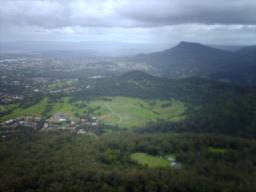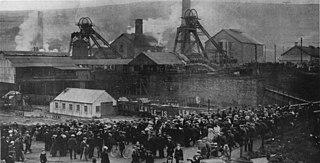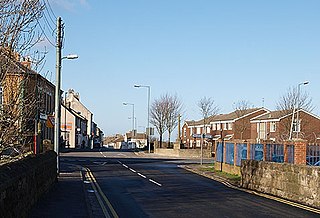
Franklin County is a county located in the U.S. state of Illinois. According to the 2010 census, it has a population of 39,561. Its county seat is Benton. It is located in the southern portion of Illinois known locally as "Little Egypt".

Marianna is a borough in Washington County, Pennsylvania, United States. The population was 626 at the 2000 census.

Coal mining is the process of extracting coal from the ground. Coal is valued for its energy content and since the 1880s, has been widely used to generate electricity. Steel and cement industries use coal as a fuel for extraction of iron from iron ore and for cement production. In the United Kingdom and South Africa, a coal mine and its structures are a colliery, a coal mine - a pit, and the above-ground structures - a pit head. In Australia, "colliery" generally refers to an underground coal mine. In the United States, "colliery" has been used to describe a coal mine operation but nowadays the word is not commonly used.

Mount Kembla is a suburb and a mountain in the Illawarra region of New South Wales, Australia.
A mining accident is an accident that occurs during the process of mining minerals. Thousands of miners die from mining accidents each year, especially from underground coal mining, although hard rock mining is not immune from accidents. Coal mining is considered much more hazardous than hard rock mining due to flat-lying rock strata, generally incompetent rock, the presence of methane gas, and coal dust. Most of the deaths these days occur in developing countries, and rural parts of developed countries.

Great Lumley is a village in County Durham, England. It is situated south east of Chester-le-Street, near Lumley Castle. It has a population of 3,843, reducing to 3,684 at the 2011 census.

The Smith Mine disaster was the worst coal mining disaster in the State of Montana, and the 43rd worst in the United States, according to the National Institute for Occupational Safety and Health (NIOSH).
A safety lamp is any of several types of lamp that provides illumination in coal mines and is designed to operate in air that may contain coal dust or gases both of which are potentially flammable or explosive. Until the development of effective electric lamps in the early 1900s miners used flame lamps to provide illumination. Open flame lamps could ignite flammable gases which collected in mines, causing explosions and so safety lamps were developed to enclose the flame and prevent it from igniting the surrounding atmosphere. Flame safety lamps have been replaced in mining with sealed explosion-proof electric lights.

The Farmington Mine disaster was an explosion that happened at approximately 5:30 a.m. on November 20, 1968, at the Consol No. 9 coal mine north of Farmington and Mannington, West Virginia, United States.

The Senghenydd colliery disaster, also known as the Senghenydd explosion, occurred at the Universal Colliery in Senghenydd, near Caerphilly, Glamorgan, Wales, on 14 October 1913. The explosion, which killed 439 miners and a rescuer, is still the worst mining accident in the United Kingdom. Universal Colliery, located on the South Wales Coalfield, produced steam coal which was much in demand. Some of the region's coal seams contained high quantities of firedamp, a highly explosive gas consisting of methane and hydrogen, and were prone to explosions.

Lingdale is a village in the unitary authority of Redcar and Cleveland and the ceremonial county of North Yorkshire, England. The village was created with the advent of ironstone mining in the area, in the early 19th century.

Mine rescue or mines rescue is the specialised job of rescuing miners and others who have become trapped or injured in underground mines because of mining accidents, roof falls or floods and disasters such as explosions caused by firedamp.

Wehrum is an abandoned coal mining company town in Buffington Township, Indiana County, Pennsylvania that thrived for a time during the early 20th Century. The mine upon which it was entirely dependent closed in 1929, and the last known inhabitants left in 1934. Essentially all that remains of Wehrum today are shadowy remnants of some of the streets and various building foundations hidden in the woods. Wehrum is considered to be one of Pennsylvania's ghost towns.

Mining in Australia has long been a significant primary industry and contributor to the Australian economy by providing export income, royalty payments and employment. Historically, mining booms have also encouraged population growth via immigration to Australia, particularly the gold rushes of the 1850s. Many different ores, gems and minerals have been mined in the past and a wide variety are still mined throughout the country. Most of what is mined is exported with relatively little processing done within Australia.

The Castle Gate mine disaster occurred on March 8, 1924, in a coal mine near the town of Castle Gate, Utah, located approximately 90 miles (140 km) southeast of Salt Lake City. All of the 171 men working in the mine were killed in the series of three violent explosions. One worker, the leader of the rescue crew, died from carbon monoxide inhalation while attempting to reach the victims shortly after the explosion.

The West Stanley colliery was a coal mine near Stanley. The mine opened in 1832 and was closed in 1936. Over the years several seams were worked through four shafts: Kettledrum pit, Lamp pit, Mary pit and New pit. In 1882 an underground explosion killed 13 men and in 1909 another explosion killed 168 men.
Mining in the United States has been active since colonial times, but became a major industry in the 19th century with a number of new mineral discoveries causing a series of mining "rushes." In 2015, the value of coal, metals, and industrial minerals mined in the United States was US $109.6 billion. 158,000 workers were directly employed by the mining industry.

Winter Quarters is a ghost town in Carbon County, Utah, United States. Coal was discovered in the area in 1875, and later that year, the Pleasant Valley Coal Company began coal mining operations. A group of coal miners were delayed during an early winter storm in 1877, which led to the town's name of Winter Quarters. On May 1, 1900, an explosion in the Winter Quarters Number Four mine killed 200 miners. Despite the mine explosion, the coal mining operations remained active until 1922, when the opening of a new mine in Castle Gate caused many people to relocate there. By 1930, Winter Quarters was abandoned.
The Scofield Mine disaster was a mining explosion that occurred at the Winter Quarters coal mine on May 1, 1900. The mine was located at 39°42′57″N111°11′17″W near the town of Scofield, Utah. In terms of life lost it was the worst mining accident at that point in American history.. The explosion is also a key element in the plot of the Carla Kelly novel My loving vigil keeping.
















